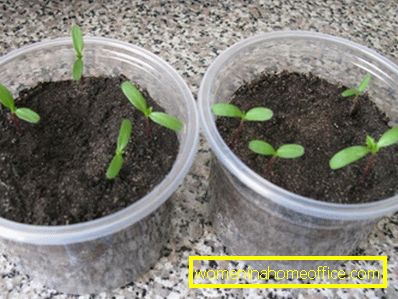When to plant marigolds on seedlings and how to plant
For flower growers, the beginning of spring comes much earlier than for other people. Throughout the winter, they look forward to the time when they can begin planting their favorite flowers. Many people like to grow marigolds. They are not only beautiful, but also hardy, unpretentious in the care of plants.
Due to this, flowers today are very popular among both beginners and experienced gardeners.
How to sow marigolds on seedlings?

Before you ask yourself when to plant marigolds on seedlings, you must purchase seeds. First of all, before the purchase, it is necessary to check the expiration date, because the germination of old seeds will take place much later.
Marigolds can be grown at once in several ways. Mainly used the method of growing through seedlings or seeds are sown immediately in open ground. When choosing 2 methods, disembarkation is carried out at the end of February or early March. After about 75-77 days from the time of sowing, the flowering of marigolds begins. That is why it would be an ideal option to sow seeds on seedlings at intervals of 1-2 weeks. Also at different times, the seedlings themselves will have to be planted in open ground. Thanks to this approach, marigolds will bloom until the first frost.
Before the time to sow the seeds is suitable, it is worth buying containers in which seedlings will be grown. To do this, you can choose as special plastic cassettes, and peat pots, mini-greenhouses or other containers that are sold in flower shops.
It is also possible to use homemade dishes. For example, empty cups of yogurt or sour cream. However, before planting, they will need to be thoroughly cleaned using simple baking soda, and at the bottom there will be made small holes that will act as a drainage.
Land for sowing seeds can be purchased at the store (soil mixture from sand, peat, humus) or in advance to prepare the soil in the fall.
How to plant marigold seeds?
Small claydite used as a drainage is laid out on the bottom of the tank, after which the ground is poured out from above. Experienced growers advise that before sowing seeds, the soil should be treated with a strong and hot solution of potassium permanganate. Sowing can be started only after all the liquid has completely drained. At the same time, the soil must not only cool but also dry slightly.
Planting marigolds on seedlings is carried out as follows - large seeds are laid in the ground to a depth of about 1 cm. Then they will have to be watered. From above capacity is covered with plastic wrap. Instead, you can use clear glass. Then the seeds are left in a fairly bright and warm place. Approximately on day 5, the first shoots begin to appear.
Characteristics of growing flowers

As soon as sprouts of marigolds begin to appear, it is possible to open capacities. After which they must be transferred so that the sun rays fall on the seedlings. It is important to know not only when to plant marigolds, but also that a sufficient amount of sunlight is necessary for the growth of seedlings. Due to this, in the future, the flowers will have a beautiful and bright color.
As soon as the first 2 leaves appear on the seedlings, the shoots can begin to swoop down. To do this, dig a sprout, and then pinch its back, after which the plant is transplanted into another container. At the same time, it deepens to approximately the level of the cotyledons. This must be done in order to improve the process of rooting. As soon as the picking is completed, the flowers should be located for several days where they are not exposed to direct sunlight.
In order to be beautiful and healthy marigolds, the cultivation of flowers should be carried out according to the rules.
- Approximately 1.5 weeks before the seedlings will be planted in open ground, it is important to begin the process of hardening. To do this, containers with plants are placed in fresh air. At the same time, it is necessary to gradually increase the duration of such air procedures. As soon as warm weather sets in, it will be possible to leave the plants outside not only for a day, but also for the whole night.
- It is not recommended to water the flowers in the evening, since the seedlings will stretch too quickly and will often get sick. It is advisable to do this only in the morning before lunch. At the same time, irrigated water is suitable for irrigation strictly room temperature.
- Since marigolds are among the heat-loving plants that are afraid of cold and frost, they can be planted in open ground only after the weather is sunny and warm. Around the end of May or the beginning of June. The ideal time for planting marigold seedlings is considered to be an early evening or an overcast day. It is worth remembering that on a hot sunny day there will be a negative impact on young and not having time to grow strong sprouts.
- Before the seedlings will be transplanted into the open ground, it is necessary to prepare the soil in advance - dig a plot, remove all weeds, and then water the soil and the seedlings themselves. Plants are dug along with part of the soil on the roots, after which they are placed in pits, the depth of which should be about 5 cm. Further around each seedling it is slightly compacted and the earth is watered again.

Marigolds can be grown as seedlings or sown in open ground. It is advisable to choose a sunny place for planting, but even in partial shade they will grow quite well. Also, these flowers are unpretentious regarding the choice of soil.
Among the advantages of marigolds can be attributed to the fact that they are bred both in pots and in shallow bowls, drawers, florists, and of course, in the garden with annual plants.
These flowers are just perfect for flower beds, as well as planting along garden paths. Low-growing species are recommended for use in large carpeting, where they look unique.
However, this plant tolerates transplant rather poorly. That is why, when it is carried out on the roots, it will be necessary to leave a small earthen room, due to which they will be much easier and faster to adapt.
Marigolds quite easily tolerate a variety of diseases and are highly resistant to various pests. In this case, periodically on the stems of plants you can see a gray rot or black leg. Therefore, they need the right care.
Marigolds are not only very beautiful, but also have useful properties. For example, the oil, which is extracted from the inflorescences of the plant, has an excellent antiseptic and antimicrobial effect. Even plucked flowers for a long time can be perfectly preserved in water.
Marigolds are completely unpretentious in care, while growing quite quickly and tolerate drought well. The plant needs periodic watering on dry and sultry days.
The most enduring seedlings of marigolds are obtained if they are grown in greenhouses or greenhouses. Today, flower shops sell special mini flower beds that can be used for this type of cultivation.
